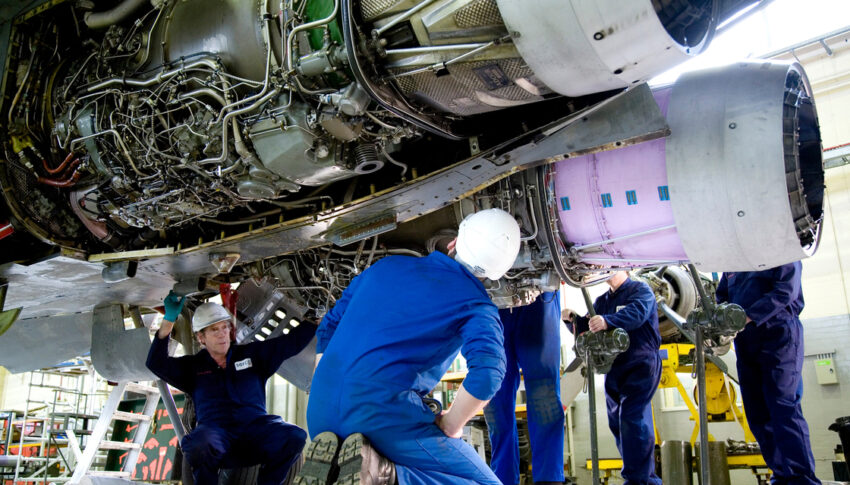Maintenance, repair and overhaul has always been a vital part of aviation. But where does the world of MRO stand at this point in time, especially in the context of the COVID-19 pandemic? What are the challenges, the opportunities and the new technologies at play — including Industry 4.0 — and where is this crucial part of the aviation industry heading?
To discuss more, we sat down with Derk Nieuwenhuijze, vice president for digital, marketing and communication at the Air France-KLM group’s MRO outfit, Air France Industries — KLM Engineering & Maintenance.
In terms of COVID-19, Nieuwenhuijze says, “obviously, the MRO industry has been hit similarly to the aviation industry as a whole.”
The impacts have been widespread, he explains: “many aircraft have been retired or long-term parked. Those that remain active fly much less, implying a strongly decreasing number of flight hours. This means less MRO activity, further amplified by the Greentime effect: postponing shop visits to save cash.”
It’s clear that the amount of uncertainty, spikiness in demand, and the overall externality of this crisis is the principal challenge to the industry more widely. This has been seen most recently in Aotearoa New Zealand, previously one of the bellwethers for recovery, where the national carrier Air New Zealand dramatically slashed its services to the bone as the country entered a Level 4 lockdown, operating just three domestic flights a day in the last weekend of August 2021. Planning — and indeed budgeting for — maintenance, repair and operations has never been so complex.
This is true both for airlines and for MRO operators, who need to manage demand for months-based, hours-based, and cycles-based MRO requirements with a finite and relatively inelastic supply: one cannot simply build an extra maintenance hangar if there is a sudden demand pressure.
Inherently, “in the coming years the recovery will continue but will be bumpy and unbalanced,” Nieuwenhuijze says, highlighting “differences between regions and aircraft types.”
“Long term,” he predicts, “we will see a shift from over-capacity to under capacity. For the narrow-body engines we already see the first signs of this. AFI KLM E&M continues to work with its our customers to ensure optimal slot availability and support.”
Within and outside the aviation industry, though, the COVID-19 crisis has accelerated digital transformation, which requires a new set of solutions to meet a new set of challenges.
Innovating out of the pandemic into fifth-gen aircraft digitalisation
During the pandemic, Nieuwenhuijze explains, “AFI KLM E&M has developed various adaptive solutions throughout its global network to adapt to our customers needs. Among many other initiatives we have developed remote inspections, adjusted work scopes and online training.”
More strategic innovation is vital to accelerate out of the pandemic as well, and innovation hubs and accelerators, like Air France Industries — KLM Engineering & Maintenance’s The MRO Lab, combine technologies including predictive maintenance for aircraft, engines, APUs and inventories with the wider digitalisation and robotics agendas to bring the fruits of next-generation technologies to its customers.
Whether that’s drones and cobots, ground-support testing equipment, automation-assisted parts repairs or virtual engine run-up training, it’s about “innovations that enable further innovation. Implementing a new technology enables us to take the next step in that same direction,” Nieuwenhuijze explains. “That is why AFI KLM E&M continues to develop and implement new solutions to support our customers and operation, even in a crisis like this one.”
But the future is, overall, a positive picture for MRO and for the wider aviation industry.
“For the long-term, says Nieuwenhuijze, “the aviation business and therefore the MRO activity will continue to show strong growth.”
Meeting the challenges of the fourth and forthcoming fifth generations of of jet passenger aircraft — where the third generation is the glass flight deck, and the fourth is fly-by-wire [PDF, p. 14] — will be critical. “Aircraft nowadays are full of electronics and generate a lot of data. Of course, general developments of technologies are being incorporated into these generations,” Nieuwenhuijze admits, highlighting that often aviation can seem to lag behind other industries, but that there’s a good reason behind that time lag. “As safety is the priority focus of everyone in the aviation sector, these changes sometimes do take a few years longer to be incorporated into an aircraft.”
Part of that fifth-generation aircraft will be dealing with the massive amounts of data created — both in terms of predictive maintenance and in terms of reactive maintenance — while also ensuring that the data is created, stored, processed and leveraged securely. Indeed, a pre-pandemic report from Oliver Wyman [PDF] revealed that less than half of the MRO operators surveyed in the company’s MRO Survey had completed a cybersecurity threat assessment.
At the same time, MROs were substantially behind the curve in establishing security standards for third-party vendors at just 9% of respondents, with some 50% of original equipment manufacturers and just over 40% of operators having these kinds of standards.
Fundamentally, “one of the next directions for future technologies is how to create value for the airlines with the data that their aircraft generate, and how we can combine that with the knowledge of a MRO provider,” Nieuwenhuijze says.
But another fundamental piece of the context is Industry 4.0 and the concomitant MRO 4.0 — both adapted for a world changed by COVID — as well as the future of product lifecycle management and the principle of designing for MRO.
Realising the benefits of this future will mean that airlines and MROs can reduce operational disruption and improve the efficiency and effectiveness of maintenance programmes.
“How aircraft manufacturers respond to the growing need for more efficient and sustainable aircraft — and what kind of technological breakthroughs may we expect here — is an important topic to follow going forward. Furthermore, it will be highly important to see how we can create even more value for airlines by working more with predictive maintenance solutions,” Nieuwenhuijze concludes.
Author: John Walton
Published: 14th September 2021
Photo credit: Rolls-Royce





